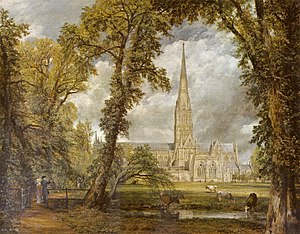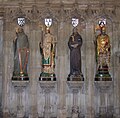Salisbury Cathedral


Salisbury Cathedral is an Anglican cathedral located in Salisbury, England.
History
The cathedral has the tallest church spire in the UK, the largest cloister in England, and one of the four surviving original copies of Magna Carta. Although commonly known as Salisbury Cathedral, the official name is the Cathedral of Saint Mary.
Building commenced when the bishopric was moved to Salisbury from Old Sarum in 1220 during the tenure of Richard Poore. Due to the high water table in the new location, the cathedral was built on only four feet of foundations, and by 1258 the nave, transepts and choir were complete. The west front was ready by 1265. The cloisters and chapter house were completed around 1280. Because the cathedral was built in only 38 years, Salisbury Cathedral has a single consistent architectural style, Early English Gothic.
The only major sections of the cathedral built later were the, Cloisters, Chapter house, tower and spire, which at 404 feet (123 metres) dominated the skyline from 1320. While the spire is the cathedral's most impressive feature, it has also proved to be troublesome. Together with the tower, it added 6,397 tons (6,500 tonnes) to the weight of the building. Without the addition of buttresses, bracing arches and iron ties over the succeeding centuries, it would have suffered the fate of spires on other great ecclesiastical buildings (such as Malmesbury Abbey) and fallen down; instead, Salisbury is the tallest surviving pre-1400 spire in the world. To this day the large supporting pillars at the corners of the spire are seen to bend inwards under the strain. The addition of tie beams above the crossing led to a false ceiling being installed below the lantern stage of the tower.
Significant changes to the cathedral were made by the architect James Wyatt in 1790, including replacement of the original rood screen and demolition of the bell tower which stood about 320 feet (100 metres) north west of the main building. Salisbury is one of only three English cathedrals to lack a ring of bells, the others being Norwich Cathedral and Ely Cathedral.
The cathedral is the subject of famous paintings by John Constable. The view depicted in the paintings has changed very little in almost two centuries. The cathedral is also the subject of William Golding's novel "The Spire" which deals with a Dean Jocelin who makes the building of the spire his life's work. Visitors can take the "Tower Tour" where the interior of the hollow spire, with its ancient wood scaffolding, can be viewed.
Chapter House and Magna Carta
The chapter house is notable for its octagonal shape, slender central pillar and decorative mediæval frieze. The frieze circles the interior, just above the stalls, and depicts scenes and stories from the books of Genesis and Exodus, including Adam and Eve, Noah, the Tower of Babel, and Abraham, Isaac and Jacob. The chapter house also displays the best-preserved of the four surviving original copies of the Magna Carta. This copy came to Salisbury because Elias of Dereham, who was present at Runnymede in 1215, was given the task of distributing some of the original copies. Later, Elias became a Canon of Salisbury and supervised the construction of Salisbury Cathedral.
Clock
The clock dating from not later than 1386 (but possibly earlier) is probably the oldest working clock in existence. The clock has no face because all clocks of that date rang the hours on a bell. It was originally located in a bell tower that was demolished in 1792. It was repaired and restored in 1956.
Choir
The Cathedral choir is also famous for having the first triplet Cathedral choristers. Matthew, Thomas and Ewan Stockwell were all appointed choristers in 1997 and left in 2003.
Organs and Organists
Organ
The organ was built in 1877 by Henry Willis & Sons.
Details of the organ from the National Pipe Organ Register
Organists
|
|
|
Images
-
The Font of Salisbury.
-
The Medieval Clock in Salisbury Cathedral
-
Inside the cathedral from the rear.
-
Statue detail from the right side of Salisbury Cathedral main front
-
Part of the main front of Salisbury Cathedral
See also
External links
- Official website
- Adrian Fletcher's Paradoxplace – Salisbury Cathedral and Magna Carta Page
- A history of the choir school and of the choristers of Salisbury Cathedral
- Flickr images tagged Salisbury Cathedral
- Panoramic Tour







